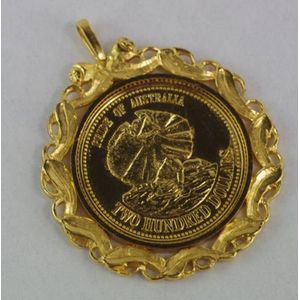Victorian Amethyst Gold Brooch, 18ct, c.1830
You must be a subscriber, and be logged in to view price and dealer details.
Subscribe Now to view actual auction price for this item
When you subscribe, you have the option of setting the currency in which to display prices to $Au, $US, $NZ or Stg.
- Filigree Work - Jewels - Filigree is delicate and intricate ornamental metal-work made from thin threads of gold or silver, soldered and twisted together to give the effect of lace. The filigree work may be freestanding, or attached to the surface of an object.
- Cannetille Work - Cannetille work is a type of jewellery-making technique that involves the use of fine wire, typically made of gold or silver, to create intricate and delicate designs. The wire is shaped and twisted into various forms, such as leaves, flowers, and scrolls, and then applied to the surface of the jewellery piece. The wire is then soldered to the piece, and the excess wire is often removed to create a smooth surface.The technique originated in the 18th century in France and Italy, and was particularly popular during the Victorian era. It was often used to decorate brooches, bracelets, and necklaces, and was a highly skilled and labour intensive technique. Cannetille jewellery is known for its intricate and delicate appearance and is highly valued by collectors.
- Victorian Period - The Victorian period of furniture and decorative arts design covers the reign of Queen Victoria from 1837 to 1901. There was not one dominant style of furniture in the Victorian period. Designers used and modified many historical styles such as Gothic, Tudor, Elizabethan, English Rococo, Neoclassical and others, although use of some styles, such as English Rococo and Gothic tended to dominate the furniture manufacture of the period.
The Victorian period was preceded by the Regency and William IV periods, and followed by the Edwardian period, named for Edward VII (1841 ? 1910) who was King of the United Kingdom and the British Dominions and Emperor of India for the brief period from 1901 until his death in 1910.
This item has been included into following indexes:
Visually similar items

A large opal pendant/brooch on chain. 14ct yellow gold, handcrafted, circa 1970's, presented as a domed kite shaped panel of finely worked gold 'bars' each etched in finish, detailed by randomly placed claw set single cut diamonds, totalling approximately

A George III sterling silver pie crust edge footed salver 1806 London, the mark of William Bateman diameter 20 cm, weight 354gms

A Victorian gold cased mourning brooch, central plaited hair compartment to black enamel surround with gold foliate feature and scroll border, 55 x 45 mm.

Australian 1989 $200 gold coin, in 9ct gold surround, total weight 16gms.
